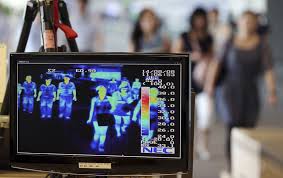
Thermal cameras could spot disease carriers at borders

Posted on :Wednesday , 13th August 2014
As the costs of thermal imaging cameras comes down, their usage extends to other applications than security, such as detecting fevers at border crossings and providing a safer method for screening patients for breast cancer, instead of less comfortable methods that expose patients to radiation such as mammography.
Thermal imaging cameras record images of the infrared radiation (heat) being emitted by the skin to determine threats. The image produced by these cameras consists of a range of colors, with hotter areas represented in red, cooler areas appearing in blue and lukewarm areas in orange or yellow for instance.
These cameras have a number of advantages over conventional CCTV security cameras including being able to detect threats in extremely low light (or even complete darkness) and during unfavorable weather conditions such as heavy fog, dust, excessive glare from the sun, or thick vegetation in the area being surveyed.
In addition, thermal cameras provide a much clearer image compared to conventional imaging solutions and have a considerably longer threat detection range when compared to lower resolution surveillance cameras that make use of conventional optics.
This makes thermal imaging cameras particularly appealing within the property security sector such as housing and golf estates, and businesses such as a car park or train station, where long perimeter fences are used.
Far wider scanning range
"Despite an entry-level thermal imaging camera costing in the region of R30,000, the overall return on investment comes across in the total cost of a company's security solutions. These thermal cameras can cover long distances of between 300 and 400 meters, whereas a company would need up to eight conventional surveillance cameras to cover the same area, at an inferior image quality with devices that are more susceptible to a range of environmental factors and conditions," says Roy Alves, regional business development manager for Axis Communications.
Just as CCTV cameras are now being used for functions that go beyond crime prevention, such as queue management within retail stores, thermal solutions are now also being employed for a range of additional functions.
Game rangers are using thermal imaging camera solutions to assist them in their attempts to catch rhino poachers.
"As thermal cameras look at people's heat signatures, they are able to detect whether someone has a fever. This can be used to alert the authorities to someone who may have been infected with the Ebola virus at crucial junctures like airports, bus stations and border crossings," concludes Alves.
Please Select an Option
-
Exhibiting
-
Visiting
-
Information

Expogroup
Expogroup is a full service exhibition organiser with over 29 Years experience in International trade exhibitions. Our current portfolio includes 28 annual exhibitions from a diverse range of industries being held across the Middle East & Africa.
EXPOGROUP © 2025 | Privacy policy